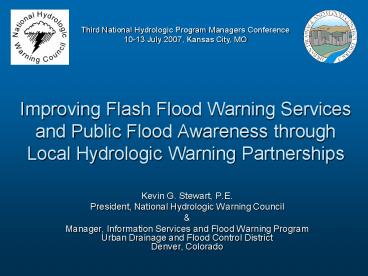Improving Flash Flood Warning Services and Public Flood Awareness through Local Hydrologic Warning Partnerships - PowerPoint PPT Presentation
1 / 33
Title:
Improving Flash Flood Warning Services and Public Flood Awareness through Local Hydrologic Warning Partnerships
Description:
Improving Flash Flood Warning Services and Public Flood Awareness through Local Hydrologic Warning Partnerships – PowerPoint PPT presentation
Number of Views:142
Avg rating:3.0/5.0
Title: Improving Flash Flood Warning Services and Public Flood Awareness through Local Hydrologic Warning Partnerships
1
Improving Flash Flood Warning Services and Public
Flood Awareness through Local Hydrologic Warning
Partnerships
Third National Hydrologic Program Managers
Conference 10-13 July 2007, Kansas City, MO
- Kevin G. Stewart, P.E.
- President, National Hydrologic Warning Council
- Manager, Information Services and Flood Warning
ProgramUrban Drainage and Flood Control
DistrictDenver, Colorado
2
Big Thompson Canyon Flash Flood
The Beginning
- July 31, 1976
Colorados Wake-Up Call
3
The Dilemma
19-foot flood depth
Big Thompson River at Canyon Mouth
4
The Impact
- 144 people killed including two law enforcement
officers 250 injured - 35 million in damages (1977 dollars)
- 418 homes and businesses destroyed as well as
many mobile homes - 438 automobiles destroyed
- Many bridges, roads, public utilities, and other
structures damaged
5
The ConcernBoulder, Colorado
Colorados No. 1 flash flood risk
6
Urban Drainage and Flood Control DistrictLocal
Flood Warning Program
The Response
- Serving the Denver/Boulder metropolitan area
since1979 in partnership with local governments
and theNational Weather Service
7
Defining the Threat
8
Early Flood Detection Evaluation
xxxxxxxxxxxxxxxxx
xxxxxxxxxxxxxxxxx
Making the initial investment
9
Boulder Creek Flood Detection Network
10
Flood Detection NetworkExpansion
- 176 ALERT Stations
- 153 Rain Gages
- 87 Stream Gages
- 18 Weather Stations
- 7 Repeaters
- 7 Base Stations
11
Widely Available Real-Time Information
12
UDFCD Flood Prediction Center
Radar SatelliteData Displays
GIS and Forecast Products
ALERTBase Stations
Staffed by private meteorologist when flood
potentials exist
13
Empowering decision makers with timely
trustworthy information
14
Basin-Specific Flood Warning Plans
- The drainage basin
- descriptions, facilities, hydrology, flood
history, problem areas, flood routing/timing - Decision aids
- ALERT system, flash flood guidance, inundation
areas - Communications
- Meteorological support
- National Weather Service
- Private Meteorologist
- Flood threat recognition and warning process
- Procedures and general responsibilities
- Public dissemination
- Media contacts
- Annual revisions and practices
15
GIS Partnering
GIS with real-time data interface aids with
threat evaluation and provides for more effective
communications.
16
Flood Depth/Inundation Mapping
GIS mapping integrated with real-time hydrologic
model.
17
A Popular Interface
18
A Popular Interface
19
A Popular Interface
20
A Popular Interface
21
A Popular Interface
22
A Popular Interface
23
Bringing key people together
24
Attracting MaintainingPublic Interest
- The toughest challenge
25
Annual Flood Hazard Notice
24,000 recipients Hazard-specific brochures
Always generates a few inquires but actual
effectiveness is unknown.
26
Partnering to Encourage Self-Help
- What to do
- Before
- During
- After
Buy flood insurance
Floodproofing ideas
Develop a familyemergency plan
27
Multi-media websites may help improve public
flood awareness
http//floodsafety.com/colorado/
28
create opportunities to maintain interest in
local flood warning programs that may be
short-lived.
Tragic Reminders
Hurricane Katrina caused concern for many
communities. Communities take steps to prepare
for their worst case flood scenario.
Hurricane Katrina Storm Surge
29
Summary
30
LFWS Sustainability
Maintain interest support by building
relationships
- Attend and host regular meetings
- Assist with developing and maintaining
basin-specific flood warning plans - Help plan and conduct annual flash flood
drills/exercises - Provide daily precipitation forecasts
- Directly notify jurisdictions of potential and
imminent flash flood threats and encourage 2-way
information exchange - Install, operate and maintain real-time
weather/flood monitoring networks and train users
often - Make effective use of text messaging, email,
paging, Internet, and fax communications (e.g.
auto-alarm notifications, short message formats,
etc.) - Make real-time data widely available
31
Information Sharing Strategic Alliances
- User Groups
- Federal, State and Local Agencies
- Educational Institutions
- Affiliated Organizations
- International Interests
32
Mission Statement
- The mission of the National Hydrologic Warning
Council is to promote the acquisition,
dissemination and utilization of hydrologic and
meteorological data in real-time for the
protection of lives, property, infrastructure and
resources, and to support the subsequent uses of
the data to improve knowledge and management of
the environment.
June 11-14, 2007
33
You make the difference!































